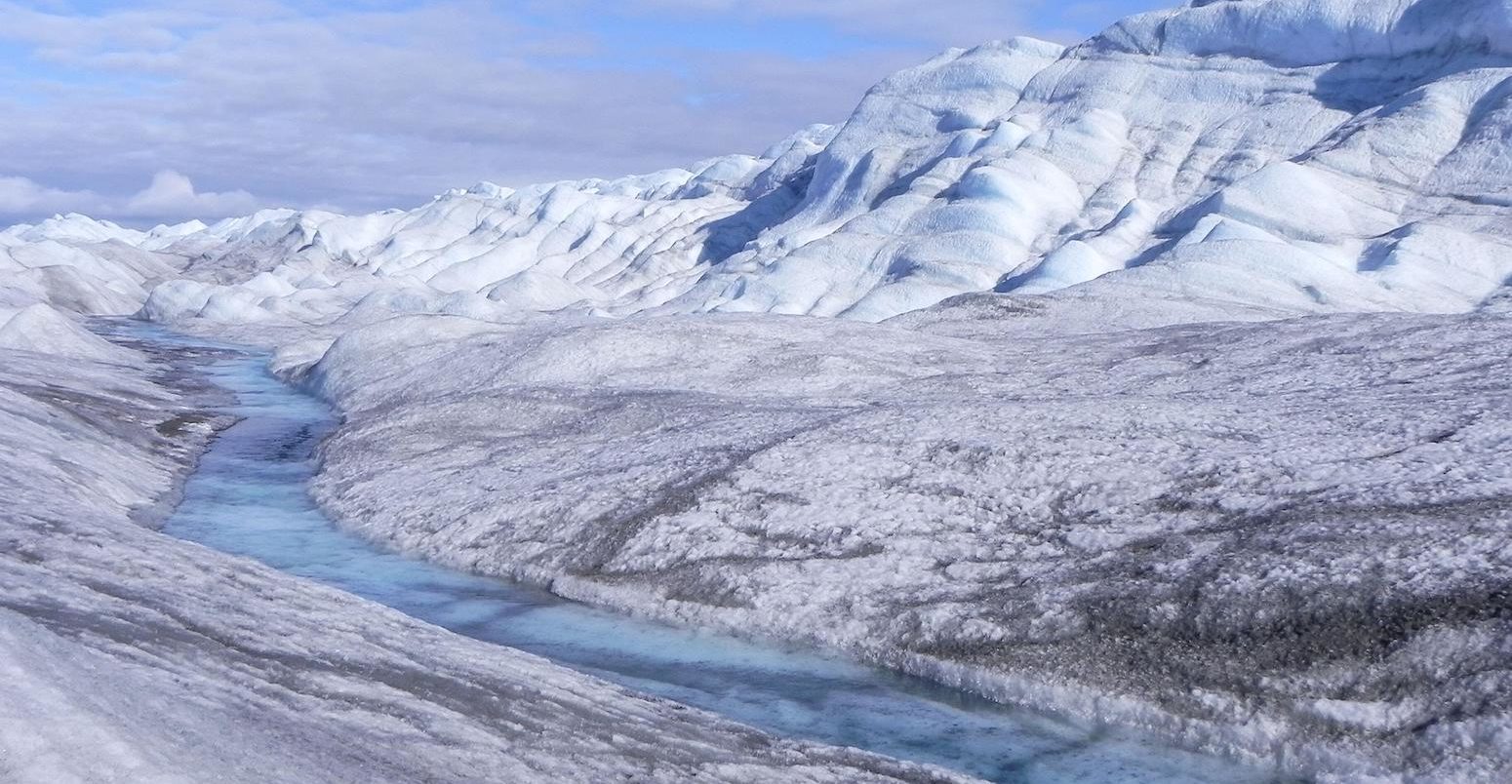
Guest post: How ancient ice-age valleys could hold the key to global ice-sheet loss

Guest authors
10.05.22
Guest authors
05.10.2022 | 1:00amAdvances in satellite technology over recent decades have allowed scientists to chart the melting of the Earth’s ice sheets in remarkable detail.
Meltwater on the surface that finds its way to the bottom of an ice sheet – and water that has been melted there directly – plays a key role in regulating ice sheet flow. Ultimately, this water can determine how quickly ice flows into the ocean and contributes to sea level rise.
Yet, because satellite records only span a few decades, they cannot tell us how this process will respond to sustained global warming over the rest of this century and beyond.
In a new paper, published in Quaternary Science Reviews, we show how giant channels, called “tunnel valleys”, were carved out beneath ancient ice sheets at the end of ice ages.
In some cases, these channels were formed in just a few hundred years as ice sheets retreated, rapidly expelling water from under the ice sheet that would have otherwise accelerated the flow of ice to the sea, increasing ice loss.
The key question is: what will be the fate of the Earth’s remaining ice sheets as both warming and melting continue?
The surprisingly fast rate at which these tunnel valleys can form means that scientists need to start considering their effects in models of how today’s ice sheets will evolve in the coming decades to centuries.
Melting ice
Ice sheets generate a colossal amount of water as they melt. In 2022, 18bn tonnes of meltwater ran off the Greenland ice sheet in just three days, enough to fill 4,500 Wembley Stadiums.
This meltwater flows through rivers atop the ice sheet and pools into giant lakes. It can then fracture all the way through the ice sheet, releasing enough energy to rival the world’s largest hydropower dams.
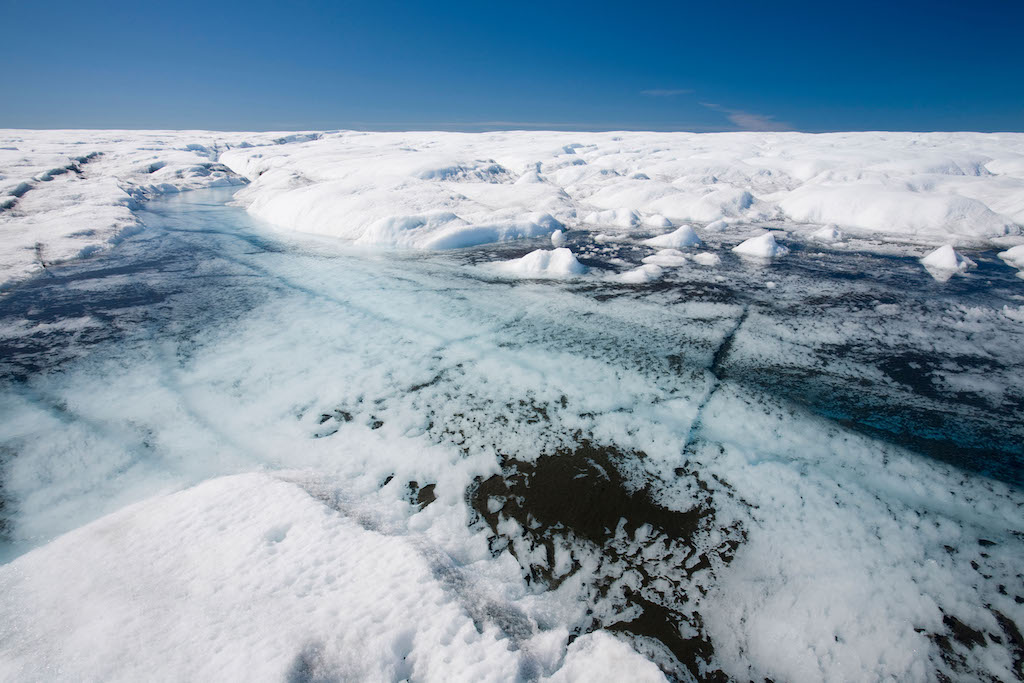
Once it makes its way to the base of the ice sheet, water can lubricate the contact between the ice and the rock that it slides over, accelerating the flow of the ice towards the ocean where it will raise sea levels.
The Greenland ice sheet has just experienced its largest September melt event on record, the kind typically only seen in the middle of summer.
With melt seasons projected to become longer and more intense in the future, understanding the effects of the corresponding increase in water at the base of the Earth’s ice sheets, how it is routed and how rapidly it is expelled will be key to predicting rates of ice loss and future sea level rise.
Studying ancient ice sheets
While the satellite record provides detailed data on ice sheets for the past four decades, the geological record of the last few million years contains evidence of multiple ice sheet growth and decay cycles over past ice ages.
Furthermore, while satellites can easily view changes on the surface of ice sheets, investigating what is happening below the ice – which can be several kilometres thick in places – is extremely challenging.
We need to consider how ice sheets change over much longer timescales in order to understand the full range of behaviours that ice sheets can, and may, exhibit in the future.
Ice sheets that flow and mould the rock beneath them leave behind imprints of their activity after they melt away. These landforms can tell us a lot about what goes on in their darkest most inaccessible depths – including, for example, the routing and influence of water beneath them.
Much larger regions of the Earth were once covered by ice sheets than today. In past cooler climatic conditions, ice sheets extended down to the mid-latitudes, blanketing parts of Europe – including the UK – in a thick layer of ice.
As cyclic changes to the Earth’s orbit around the sun caused the climate to warm, these ice sheets decayed, leaving behind traces of their death throes as part of the geological record.
Thousands of giant channels – called tunnel valleys – carved by escaping meltwater during deglaciation of the British-Irish and European ice sheets now lie, buried under mud, at the bottom of the North Sea.
These channels – shown in the map below – can be up to 150 kilometres (km) long, 6km wide and 500 metres deep, each one several times larger than Loch Ness in Scotland.
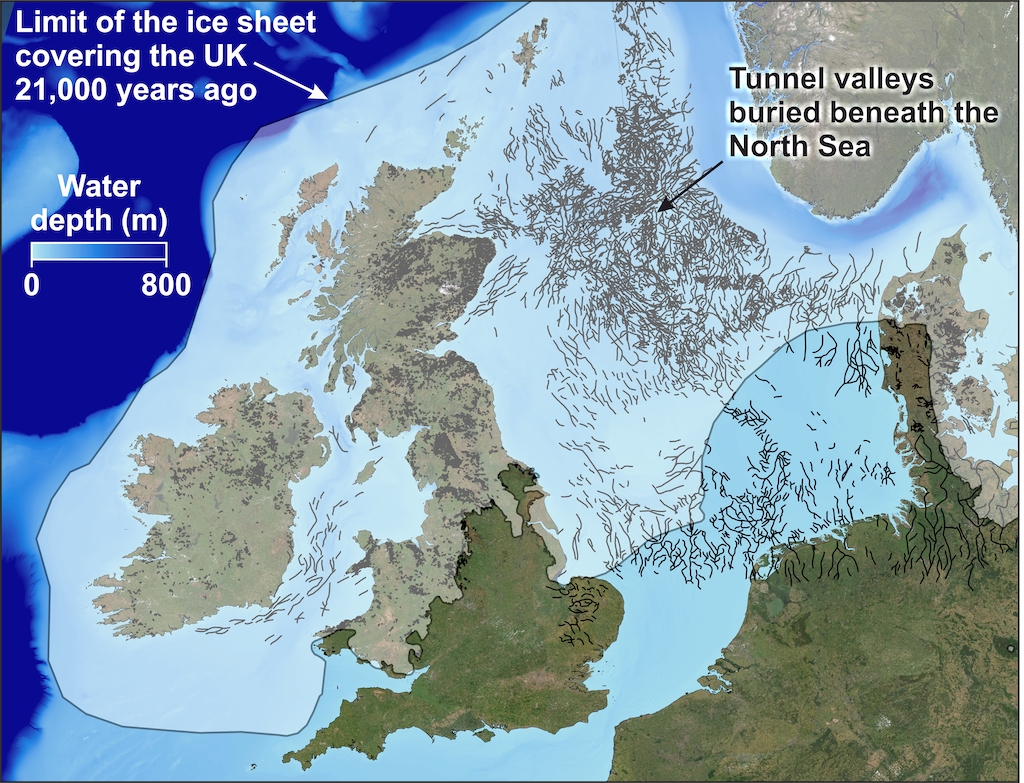
Human-driven climate change is now causing the margins of Earth’s last remaining ice sheets – situated in naturally colder polar climates – to experience conditions similar to those that melted the ice sheets situated at lower latitudes during the last deglaciation, which started approximately 20,000 years ago.
Analysing the giant channels produced by ice sheet melting provides a window into a future warmer world, which we can use to learn lessons about how Greenland or even Antarctica could respond in the future.
The death throes of ancient ice sheets
Our previous study took seismic data – originally collected to detect drilling hazards in the search for oil and gas beneath the North Sea – and repurposed it to provide imagery of the geological layers beneath the Earth’s surface.
We used this data to show that tunnel valleys influence the flow of ice sheets during periods of extreme climatic warmth. The image below shows one such tunnel valley revealed by peeling back the seafloor of the North Sea. The alternating red and black lines indicate stacked layers of mud and rock beneath the seafloor.
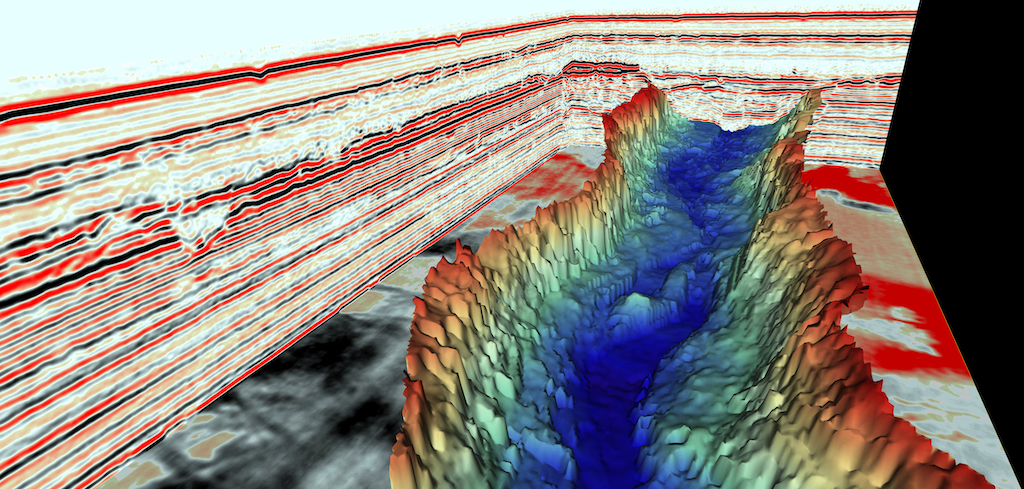
However, pressing questions remained such as: by what mechanisms and how quickly are the giant tunnel valleys carved out? How is meltwater evacuated through the tunnel valleys? And how did the ice above respond as water drained through them?
To address these questions, our new research combines state-of-the-art seismic data over tunnel valleys with a new reconstruction recording how the ice sheet that covered the UK during the last glaciation decayed when the climate warmed. This ancient ice sheet raised sea levels by 1.8 metres as it melted, and the reconstructions provide the most well-documented example of ice sheet retreat anywhere in the world.
The animation below shows the build-up and decay of this ice sheet between 31,000 and 15,000 years ago. Each image represents the change in ice sheet shape every 1,000 years as it grows and retreats across the UK (centre of image), North Sea (centre-right of image) and Scandinavia (right of image). The colours of the ice sheet represent the velocity of the ice, with blues depicting slower flowing ice and reds showing faster flowing ice.

New findings
Combining geological evidence and modelling simulations, we show that enormous tunnel valleys can be eroded beneath ice sheets experiencing extreme warmth within just several hundred to a few thousand years.
This is because they are carved mainly by highly erosive, fast-flowing water in smaller channels that tend to form at their base, while ice fills most of the valley above, pressurising the water in the channels.
This is shown in the graphic below, which illustrates these channels, fed by melting at the base of the ice sheet and surface meltwater that reaches the base via “moulins” – vertical shafts through the ice created by running water.
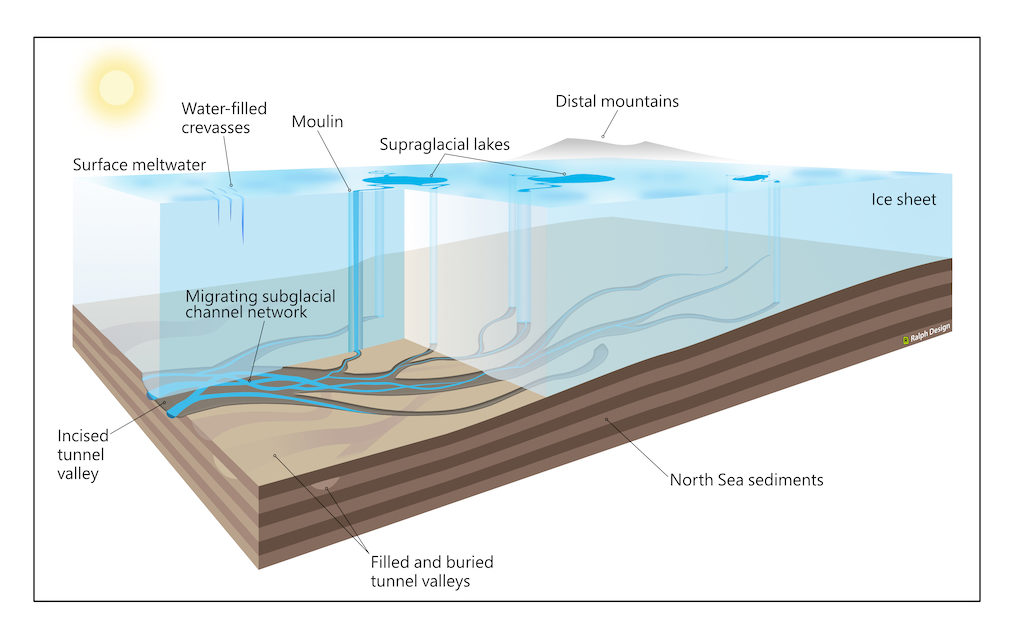
A few hundred years might sound like a long time, but this process is very quick compared to the life cycle of an ice sheet. The beginnings of these giant tunnels can appear within a few decades, expelling water that could otherwise accelerate ice flow towards the ocean.
Traditionally, the drainage of water from beneath ice sheets is thought to stabilise ice flow by removing lubricating water from the ice sheet bed. Logically, it then follows that the rapid formation of tunnel valleys could, therefore, buffer modern ice sheets from catastrophic collapse if they were to become a factor as melt rates increase in a warming climate.
However, it is not this simple. Our detailed 3D seismic scans display tell-tale signatures of ice that has both stagnated – that is, stopped suddenly – but also flowed rapidly within the tunnel valleys.
Therefore, it appears that the flow of meltwater through these giant channels may, under different circumstances, act to either slow or accelerate ice flow. Why these patterns of behaviour occur in some instances and not others remains a pressing question to investigate in the future.
What is certain, though, is that the surprisingly fast rate at which these tunnel valleys form means that scientists must consider them in models of how today’s ice sheets will evolve in the coming decades to centuries.
The fate of modern ice sheets?
There are no modern examples for the rapid erosion of tunnel valleys beneath today’s ice sheets. This is probably because they are currently not producing enough melt – yet.
However, these ancient valleys, now buried hundreds of metres beneath the muds of the North Sea seafloor, record a mechanism for how ice sheets respond to extreme warmth that is missing from present-day ice-sheet models.
Such models do not currently resolve fine-scale water drainage processes, despite them appearing to be an important control on ice flow, ice loss rates and, ultimately, sea-level rise.
Our new study highlights a currently overlooked process that can rapidly switch on beneath melting ice sheets.
Whether these channels will act to stabilise or destabilise the Earth’s contemporary ice sheets in a warming world remains an important and open question.
Kirkham, J. D. et al. (2022) Tunnel valley formation beneath deglaciating mid-latitude ice sheets: Observations and modelling, Quaternary Science Reviews, doi:10.1016/j.quascirev.2022.107680
-
Guest post: How ancient ice-age valleys could hold the key to global ice-sheet loss





